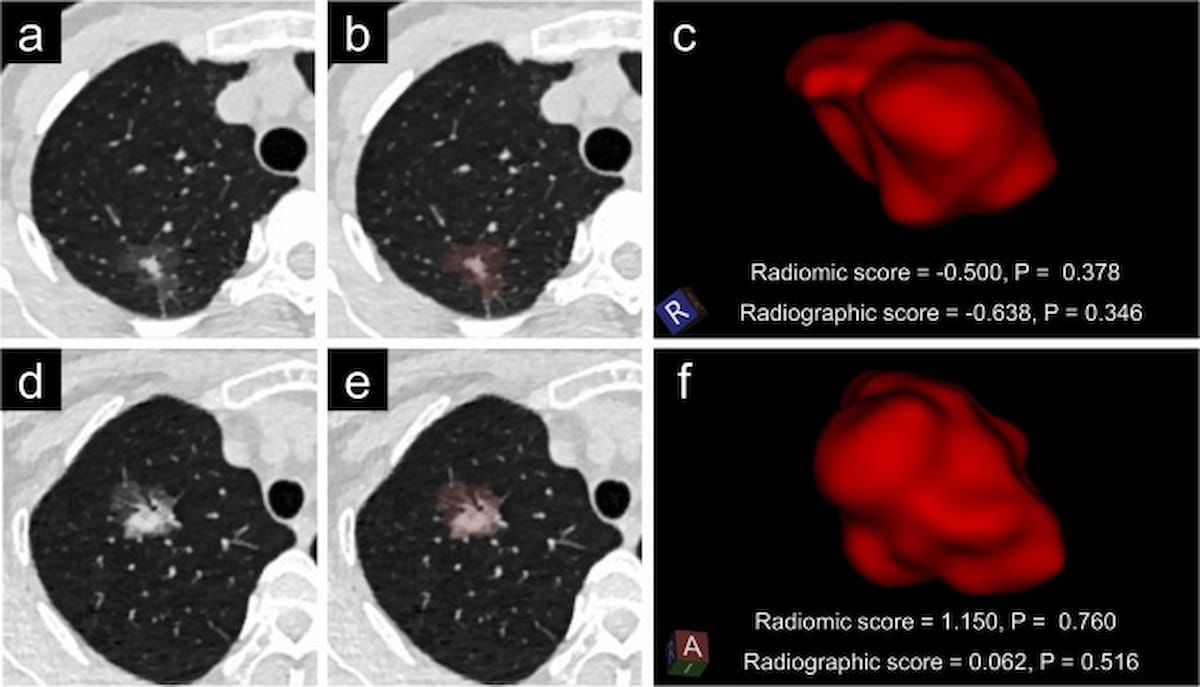Based off of low-dose computed tomography (LDCT) assessment, an emerging radiomic model may provide enhance prognostic capabilities for predicting high-risk lung adenocarcinoma (LUAD), according to newly published research.
For the multicenter retrospective study, recently published in Academic Radiology, researchers developed and compared radiomic and radiographic models using data from 658 patients with LUAD.
In external validation testing, the study authors found that the radiomic model offered a 93.8 percent area under the curve (AUC) for predicting high-risk LUAD in comparison to 88 percent for the radiographic model.
In addition to higher sensitivity (79.1 percent vs. 76.7 percent) and negative predictive value (86.6 percent vs. 83.6 percent), the radiomic model provided over 10 percent higher specificity (89.2 percent vs. 78.5 percent) and over 12 percent higher positive predictive value (82.9 percent vs. 70.2 percent), according to the researchers.
“These findings suggested the LDCT-based radiomic score … was a potential non-invasive biomarker to predict the high-risk LUADs and might provide guidance for personalized clinical decision-making of part-solid and solid nodules during lung cancer screening,” wrote study co-author Jieke Lu, M.D., who is affiliated with the Department of Radiology with the Sichuan Clinical Research Center for Cancer at the Sichuan Cancer Hospital and Institute in Chengdu, China, and colleagues.
The researchers said the radiomic model included three texture features with an emphasis on gray-level intensity. The GLCM_Correlation feature, reflecting linear dependency of gray-level values on respective voxels, was associated with a nearly 2.7-fold higher likelihood for the development of high-risk LUAD, according to the study authors.
Three Key Takeaways
1. Enhanced predictive accuracy. The radiomic model based on low-dose CT (LDCT) demonstrated superior prognostic performance for identifying high-risk lung adenocarcinoma (LUAD) compared to traditional radiographic models, with a higher AUC (93.8 percent vs. 88 percent), specificity, and positive predictive value.
2. Non-invasive biomarker. The LDCT-based radiomic score shows promise as a non-invasive biomarker, aiding personalized clinical decision-making for patients with part-solid and solid lung nodules during lung cancer screening.
3. Insights into radiomic texture features. Radiomic texture features, such as GLCM_Correlation and GLSZ_SmallAreaEmphasis, may provide insights into tumor heterogeneity and phenotypes of high-risk LUAD that traditional radiographic methods cannot capture.
Similarly, the study authors found that the GLDM_LargeDependenceHighGrayLevelEmphasis feature (measurement of joint distribution of large dependence of small size zones) and GLSZ_SmallAreaEmphasis feature (measuring distribution of small size zones) were associated with nearly 3.5-fold higher and over fourfold higher likelihoods, respectively, for LUAD occurrence.
“All these texture features provided a measure of tumor heterogeneity, which might capture the distinct phenotypes of the high-risk LUADs that could not be described through traditional radiographic features,” added Lu and colleagues.
(Editor’s note: For related content, see “CT Study Links Better Five-Year Prognosis with Minor Ground Glass Opacity Component in NSCLC Lung Nodules,” “Can Deep Learning Models Improve CT Differentiation of Small Solid Pulmonary Nodules?” and “AI Adjudication Bolsters Chest CT Assessment of Lung Adenocarcinoma.”)
In regard to study limitations, the authors acknowledged possible patient selection bias with the retrospective study. In addition to noting a relatively small sample size for development and validation of the radiomics model, the researchers emphasized the need for large-scale prospective studies to determine the applicability of the radiomics model to standard-dose CT or LDCT data derived from different acquisition criteria and scanners.
